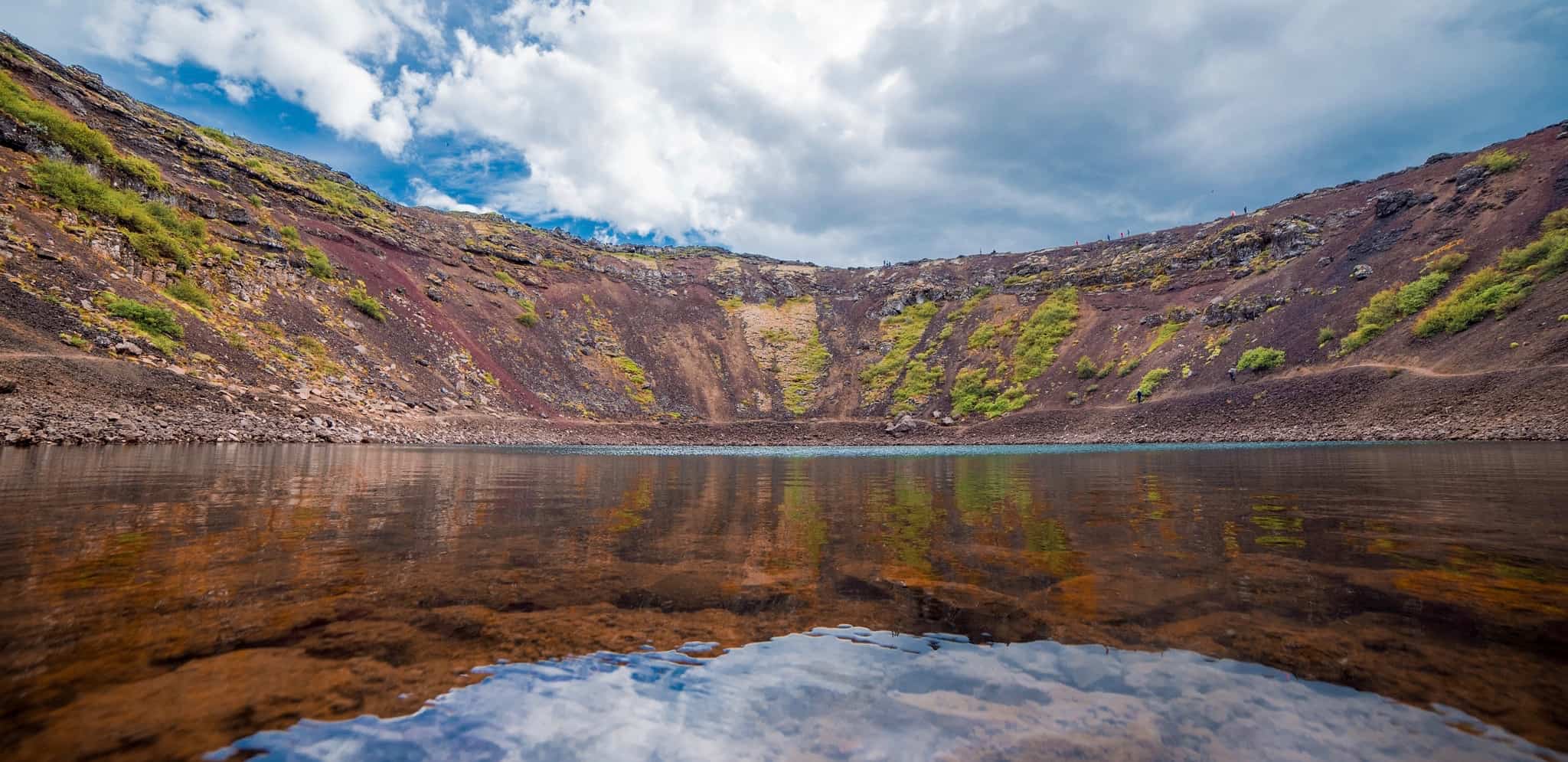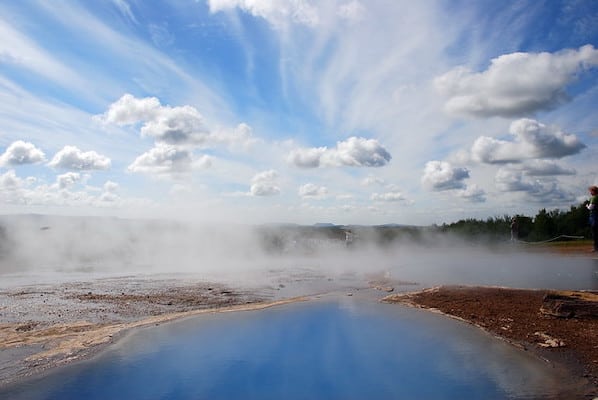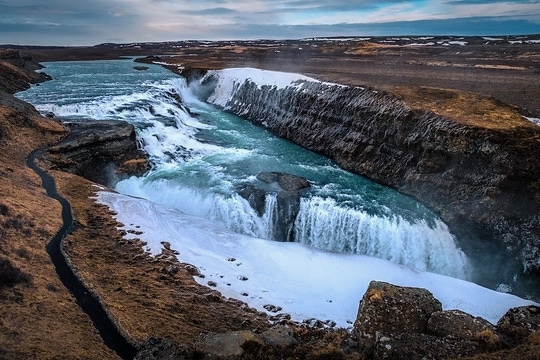ICELAND
Around the Golden Circle
By Julie Marinelli
New Britain, CT, United States
Iceland’s landscape holds dramatic features in a concentration seen nowhere else on earth. You can find active volcanoes, glaciers, and a valley where the country is literally being pulled apart. A one-day drive along the roads known collectively as the Golden Circle will show you why this country is called the Land of Fire and Ice. You’ll see powerful waterfalls, a national park, and Geysir, the place that gave its name to modern geysers everywhere.
The route starts in the capital city of Reykjavik then heads toward the center of the island. It loops around to bring you, 155 miles (250 kilometers) later, back to where you started. The Golden Circle gets its name in part from a waterfall along the way called Gullfoss, meaning “golden falls.”
First, Some History
If you chose to go directly east, your first stop is Thingvellir National Park, a location 28 miles away that carries significant historical and geological value. It was the first national park in Iceland, created to preserve the site of the country’s first parliament, which was founded in 930 CE. Iceland is one of two countries that hold the record for the world’s oldest surviving parliament. Thingvellir has been designated a UNESCO World Heritage Site. Its main geological attraction is the rift where the Eurasian and North American tectonic plates are moving apart at a rate of two centimeters per year.
Geysers in Geysir
Your next stop is Geysir geothermal field. Located in a volcanic zone, numerous hot springs fill the air with steam and sulfur. Here the Great Geysir lies dormant. However, only 300 feet (ft.) away, the Strokkur geyser erupts every 5 to 10 minutes. This one can blow water up to 65 ft. in the air! Because the soil contains sulfur, copper and iron, you’ll see patches of ground in vivid shades of yellow, green, and red.
Halfway Point
Driving a little farther north, you’ll come to the Gullfoss waterfall. The most famous one in Iceland, it flows from the country’s second largest glacier. The waterfall has two large steps (dropping 36 and 71 ft.) and falls into a 105-ft. crevice. It is so powerful that you can feel the mist and rumbling from the observation point.
Geothermal Greenhouse
Hungry for lunch yet? Head south to Fridheimar Greenhouse. Don’t let the cold fool you, because underneath your feet is an abundant supply of geothermal energy. The naturally occurring hot water is used to heat greenhouses where tomatoes grow year round. The greenhouse restaurant will serve you all things tomato: soup, ravioli with tomato sauce, and tomato and mozzarella tortillas.

One Final Sight
The final leg of the trip takes you to Kerid volcanic crater. What was once a cone-shaped volcano collapsed into a crater after a violent eruption 3,000 years ago. At 180 ft. in depth, the relatively young age of the crater means it has vivid red sides. The lake contained within the crater is a stunning blue due to mineral deposits. Take some time to appreciate this incredible geological site before heading back to Reykjavik.
Now that you’ve spent a day sampling Iceland’s unusual beauty, you’ll undoubtedly want to see more. Luckily for you, an even longer road encircles the entire island. Pack up and get ready for 828 miles of fascinating scenery along Iceland’s Ring Road!
Have a suggestion for this story? We’d love for you to submit it!


Blank
Blank
Math Resources
Learning Activity:
- Connecting to the Standards: Geometry (Grade 8)
Sample Problems:
- Grades 2–3: Your family decides to make a day trip around the Golden Circle. First you drive 47 kilometers to Thingvellir National Park. Then you drive 79 kilometers to the geysers and Gullfoss. If the whole trip is 250 kilometers, how much farther will you have to drive to get back to where you began? If Kerid Crater is 173 kilometers from Reykjavik, and you stop there next, how far is the crater from Gullfoss?
- Grades 3–6: At Thingvellir National Park, the Eurasian and North American tectonic plates are moving apart at a rate of two centimeters per year. I was there in 2017. How far apart have the plates moved since then? How far apart will they have moved by 2035 (starting at 2017)? How many years does it take the tectonic plates to move a whole foot apart (about 30 centimeters)?
- Middle School: Kerid Crater is 558 ft. across. What is the radius of the crater? What would be the circumference of the rim of Kerid Crater (2?r)? If Kerid Crater was a perfect cylinder and is 180 ft. deep, what would be the volume (?r²h)?
Social Justice Questions
In the early 1900s, a farmer owned the land surrounding Gullfoss. Investors offered to buy it from him and turn the waterfall into a hydroelectric plant. Instead, the farmer’s daughter fought to preserve the waterfall. It eventually became the property of the Icelandic people in 1929, ensuring its conservation.
If the waterfall had become a hydroelectric plant, some estimates say it could have produced 2,444 gigawatt hours per year. For reference, one gigawatt can illuminate 100 million LED lights. According to Orkustofnun, Iceland’s National Energy Authority, the country’s total energy consumption totals about 18,000 gigawatt hours per year. Which of these choices do you think would benefit the Icelandic people more? Why?
- Conserve the waterfall as an environmental asset
- Produce clean, renewable electricity
Explore Further
- A guide to the Golden Circle route
- The dramatic conservation story of Gullfoss waterfall
- Thingvellir National Park website
- Fridheimar Greenhouse website
- Views of Iceland’s scenery by drone
Share Your Story
Write your own Global Math Story and send it to us!
Sorry, the comment form is closed at this time.